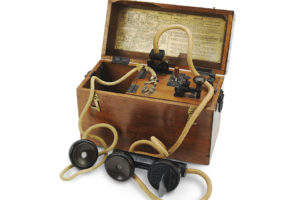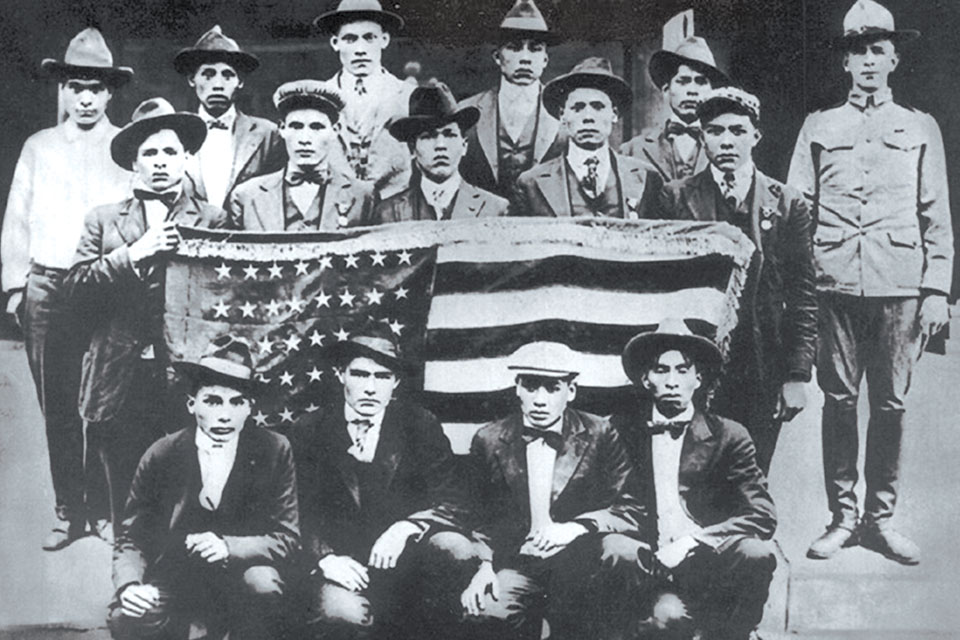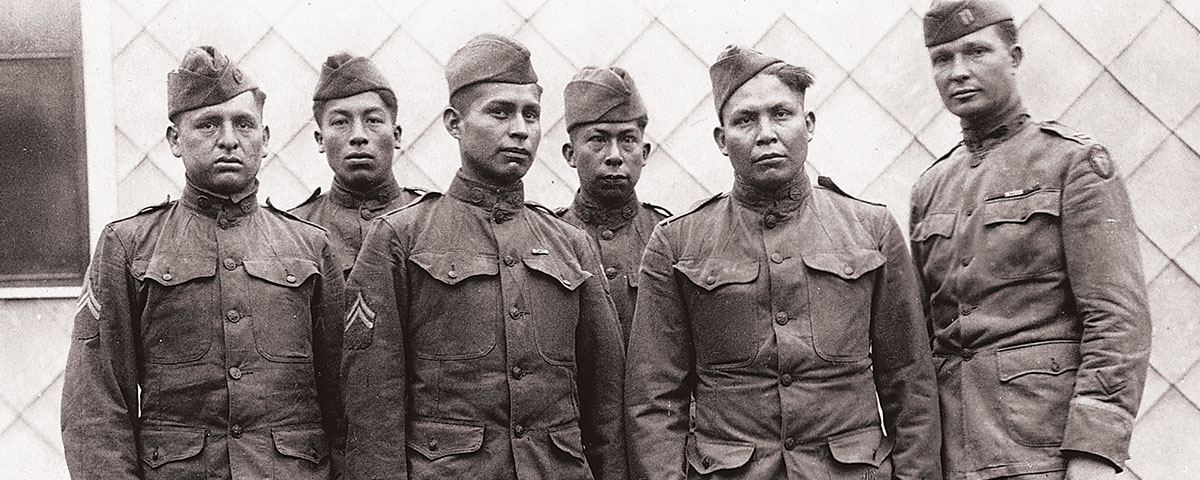Near an abandoned French farm in 1918 field telephones crackled with orders in a language that baffled German eavesdroppers—and the code talkers were born
During World War II the United States used American Indian code talkers to thwart enemy decoding of battlefield radio and telephone traffic. The exploits of these men—almost all of whom were Navajos serving with the Marines the Pacific—are justly famous, thanks to several popular written histories and the 2002 film Windtalkers.
Yet few people realize that U.S. reliance on code talkers during wartime did not originate with Navajos on some jungle-covered South Sea island. It was, instead, on the shell-pocked Western Front battlefields of World War I that American Indians—mostly Choctaws in Army uniforms—were first tasked with transmitting crucial military communications in languages the enemy could not decipher.
Throughout history military forces have gone to great lengths to keep their written operational messages safe from the enemy’s prying eyes, using complex codes, invisible ink and scores of other methods to render sensitive missives unreadable. By the early 20th century the widespread adoption of field telephones and radios made it far easier for land, sea and air forces to transmit vital information—movement orders, target coordinates, etc. Yet these means of relaying data had one glaring vulnerability: The enemy could listen in. Radio communications were wholly indiscriminate. While telephones of the period transmitted information across physically connected land lines, the miles of required communications wire crisscrossed battlefields in plain sight, lying exposed on the ground or strung atop poles. The Germans easily tapped into the lines, thus learning Allied plans and objectives. “There was every reason to believe,” one U.S. officer informed his commander, “every decipherable message or word going over our wires also went to the enemy.” To counter such eavesdropping, the Army turned to coded communications, but the enemy became adept at breaking the ciphers. Moreover, decoding messages under combat conditions took too long.
Enter the Choctaws.
Technically, the Selective Service Act of 1917, which authorized the military conscription of eligible men, did not apply to American Indians, as they were not considered U.S. citizens. In fact, at least two Indian nations unilaterally declared war on Germany. Regardless, the Office of Indian Affairs established draft boards on the reservations and compelled thousands of men into U.S. service. Wartime Commissioner of Indian Affairs Cato Sells played on others’ martial pride, patriotism and employment needs to convince thousands more to volunteer. By war’s end more than 10,000 tribesmen, representing nearly 20 percent of the entire adult male American Indian population, had served in the armed forces. Many were Oklahomans of the “Five Civilized Tribes”—Cherokee, Chickasaw, Choctaw, Muscogee (Creek) and Seminole.

The Choctaw and Cherokee were among 14 tribes that provided men to the 1st Infantry Regiment of the Oklahoma National Guard. After basic training at Fort Sill, in October 1917 the Oklahoma guardsmen shipped out to Camp Bowie, Texas, where they combined with Texas guardsmen to form the 36th Division under Maj. Gen. Edwin St. John Greble. The 36th was organized into two brigades, the 71st and 72nd, the former comprising the 141st and 142nd regiments, the latter the 143rd and 144th. Its ranks included more than 600 American Indians. Company E of the 142nd was known as the “millionaire company,” as its ranks included oil-rich Indian landowners who received eye-popping royalty checks from drilling companies. Some tribesmen in the 36th received government allotment checks, though many had to be satisfied with their basic Army pay. Sells took a personal interest in his charges, visiting them in camp to see they were well treated—and of course to pose with them for publicity photos.
Occupying nearly 2,200 acres of prairieland west of Fort Worth, Camp Bowie was one of 16 National Guard training camps established nationwide in the spring and summer of 1917. It received its first trainees on August 24 while construction was still under way (by war’s end more than 100,000 men would pass through). It was an all-American cantonment, housing whites, blacks and American Indians. But while black units were largely relegated to support roles and trained separately, white and Indian recruits trained for combat side by side. Indeed, white commanders welcomed the Indians for their reputed martial spirit. The stereotype was prevalent. According to an article about Indian servicemen in The Outlook, a popular journal of the era, their “adroit tactics, sense of strategy and feats of camouflage [were] the outgrowth of an ancient training in the science of war.” According to another period report one Cherokee recruit wanted to skip basic training and go straight to France so he could “bayonet the Kaiser all by himself.”
Such reports warmed the hearts of Army brass, and field officers couldn’t wait to turn their Indians loose on the Germans. Privately, however, some harbored doubts prompted by other stereotypes. Sure, Indians might be fine as mounted raiders, they argued, but they’d never be able to endure long marches or adhere to military discipline. Lt. Lucien B. Coppinger, who trained Indians at Camp Bowie, reported his recruits were “self-conscious, easily amused and take a great interest in fieldwork as opposed to close-order drill.” Still other preconceptions worked in their favor. As they were used to primitive living conditions on the reservation and had been taught from birth to be stoic, some officers noted, they endured the rigors of training with little complaint and made particularly hardy soldiers. Stereotypes and preconceptions aside, the Indian recruits largely passed all tests with flying colors.
The chosen insignia of the 36th Infantry Division was a blue flint arrowhead (representing Oklahoma) superimposed with the letter T (for Texas), and its 30,000 men wore their shoulder patches with pride on April 11, 1918, during their first public parade through downtown Fort Worth, attended by more than 200,000 people. In July the division boarded northbound trains and within weeks shipped out from Hoboken, N.J., bound for Europe. In the rush to get the troops to the front, the men arrived in France without much of their equipment. Their training was also incomplete, having never handled live grenades and only recently been trained in the use of Browning rifles and machine guns. After supplemental training in trench warfare, the division moved up to the front lines in late September.
The 36th Division arrived just in time to participate in the last great Allied offensive on the Western Front. The American unit was attached to the French Fourth Army, its 71st and 72nd brigades split between the Meuse-Argonne and Champagne sectors. The 36th went into action for the first time on October 8 in relief of the U.S. 2nd Division. The men from Oklahoma and Texas charged forward, driving the Germans off the heights around Saint-Étienne and ultimately pushing them back to the Aisne River. Between October 8 and 12 the 36th was in continuous combat, repulsing repeated counterattacks and keeping pressure on the Germans, despite suffering heavily from artillery, poison gas and machine-gun fire.
The division’s American Indians were assigned to scout and sniper units. Some of the scouts found themselves attached to the intelligence section as runners, which brought them to the attention of senior officers. One of the high command’s biggest concerns was securing lines of communication between headquarters and frontline units. Runners were frequently killed or captured, rocket signals conveyed only limited information and the telephone lines were clearly being tapped. Without timely orders, some field officers were sending their troops forward at the first sound of the guns.
According to the division’s official history, the solution came during a lull in the fighting when Capt.Elijah W. Horner of the 142nd overheard two of his company’s Choctaw soldiers conversing in their native tongue. Immediately recognizing the possibility of using them to frustrate enemy eavesdropping, Horner approached regimental commander Col. Alfred W. Bloor, who concurred. At least that’s the official version. Another version, recounted years later by the daughter of Choctaw code talker Albert Billy, is that her father first floated the idea to his superiors. Regardless of who conceived of it, everyone was on board, for as Bloor so aptly put it, “There was hardly one chance in a million Fritz would be able to translate these dialects.” Word came down from regimental and brigade headquarters to put the Indians on field telephones and send all sensitive communications through them. Choctaws from Company E were soon posted to every field headquarters, their ears glued to telephone receivers.
The division first put the new system to the test on the night of October 26. The 71st Brigade had orders to dislodge the Germans from a strongly fortified position named Forest Farm in a loop of the Aisne River. The position had to be neutralized, as it was holding up the Allied advance at the river. The 141st and 142nd regiments were assigned the task. Division commander Maj. Gen. William Ruthven Smith strongly suspected the Germans were listening in on his communications and tested his theory by issuing false orders to establish an outpost on a certain hill. Shortly thereafter, German artillery fire obliterated the hill. That was all the evidence Smith needed.
When Bloor had to withdraw two of the 142nd’s companies on the night of the 26th, he used two code talkers—Solomon Louis at division headquarters, and James Edwards in the forward area—to relay the message. The subsequent repositioning was accomplished without mishap and without alerting the Germans. The next morning the assault went forward on Forest Farm with code talkers again manning the telephones. The Germans were caught by complete surprise, the Americans overrunning the position within an hour. In his after-action report Bloor generously attributed the regiment’s success to secure communications. After the 142nd was pulled out of the line to rest and refit, the Choctaw troops under Capt. Walter Veach were detailed to train other tribal members in the new system.
Training was needed, as much of the system was improvised. The Indian signal-men could not just relay information in their native tongue, as Choctaw had no equivalents for machine guns, heavy artillery, tanks and the like. Amerindian languages are holophrastic (expressing complex ideas in a single word) and polysynthetic (combining several words into one word), thus the code talkers adapted Choctaw vocabulary to military jargon. The result was a sort of pidgin English in which “big gun” meant artillery, “little gun shoot fast” meant machine guns, a regiment was a “tribe,” battalions were “grains of corn” and casualties were “scalps” (which must have struck the Choctaw as amusingly ironic). Eighteen men received training and were designated by the Army as Class I code talkers, as opposed to Class II code talkers not trained in the special jargon, who spoke “in the open” in their native tongue.
Unfortunately for the Choctaws of Company E, all their hard work was for naught. The regiment never got back into the fight, as the November 11 armistice went into effect before they returned to the lines. Based on the single engagement at Forest Farm, however, Bloor was a believer. “Had the regiment gone back into the line,” he stated in his report, “fine results would have been obtained.” Years later a tribal official of the Choctaw Nation, with understandable pride, credited the code talkers with “likely bringing about an earlier end to the war and saving hundreds of thousands of lives.” And the U.S. Army honored their contribution: The Choctaw code that had served so well in 1918 remained officially classified for decades to come.
Gauging the exact number of code talkers is difficult, let alone distinguishing Class I from Class II signalmen. Choctaw history points to eight original members of Company E who went on to train others. All members of the original group were either full-blood or mixed-blood Choctaw. Oral history interviews with the tribe later identified 14 code talkers by name, yet it is certain there were more. Army records name 16 from the 142nd regiment and two more from the 143rd. The youngest was 19, the oldest 33.
The 36th Division returned to the United States seven months after the fighting in Europe ended, having suffered 2,584 casualties—including 466 killed in action. In June 1919 the division was inactivated at Camps Bowie and Travis, Texas.

In one postwar portrait (see above) 14 young Choc-taw veterans in civilian clothes pose with an American flag while a white uniformed officer stands apart from them. Nothing distinguishes them as soldiers except the medals several wear on their jacket lapels. Reportedly, they were as proud of having “fooled the Germans” as they were of their combat decorations. The code talkers and all other American Indian soldiers who fought in World War I remained foreign nationals until 1924, when Congress extended citizenship to all tribes. Even then, full recognition of their service was slow in coming. Regardless, the patriotism of Native Americans for their adopted country continued to burn brightly. At the outset of World War II original Choctaw code talker James Edwards tried to re-enlist as a 43-year-old, reasoning “maybe [the Germans] still can’t talk Choctaw.” Rejected due to his age, he still managed to serve his country as an employee of the Bureau of Indian Affairs.
While Col. Bloor’s Jan. 23, 1919, after-action report represented the first official recognition of World War I code talkers, more fitting tributes were to come. In 1995 the Choctaw Nation erected a war memorial on its capitol grounds in Tuskahoma, Okla., which includes a magnificent polished granite slab commemorating the original Choctaw code talkers of World War I. It lists 18 men. Two additional Choctaw code talkers have since come to light. In 2007 the Texas Military Forces Museum in Austin mounted an exhibition on the Choctaw code talkers, and the National Cryptologic Museum in Annapolis Junction, Md., also has a permanent exhibit in their honor. In 2008 President George W. Bush signed the Code Talkers Recognition Act into law. “At a time when Indians were discouraged from practicing their native culture,” said bill cosponsor U.S. Sen. John Thune of South Dakota, “a few brave men used their cultural heritage, their language, to help change the course of history.”
Perhaps the most fitting recognition of the World War I code talkers was the impact of their legacy on later conflicts. In World War II the U.S. government recruited several hundred American Indians from various tribes to serve as radiomen, and Navajo code talkers in the Pacific Theater developed a complex cipher employing some 600 military terms. During the Cold War a 1950 National Security Agency study looking into the potential use of American Indians as communication linguists cited the 142nd Regiment’s October 1918 field experiment, calling it the precedent for similar use.
Whether fighting Germans or Japanese or Soviet Russians, the code talkers were always ready to serve.
Richard Selcer is a history professor at Weatherford College in Texas and an author with 10 books to his credit. For further reading he recommends The 90th Division in World War I, by Lonnie J. White; Texas and Texans in the Great War, by Ralph A. Wooster; Story of the 36th, by Captain Ben. F. Chastaine; and Camp Bowie Boulevard, by Juliet George.





